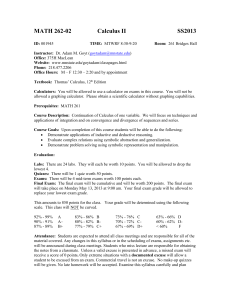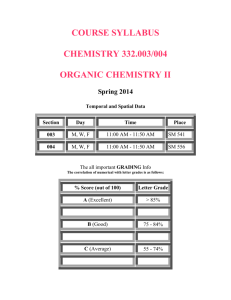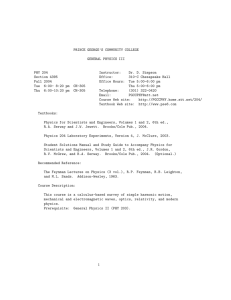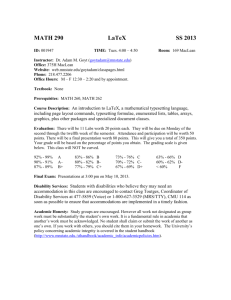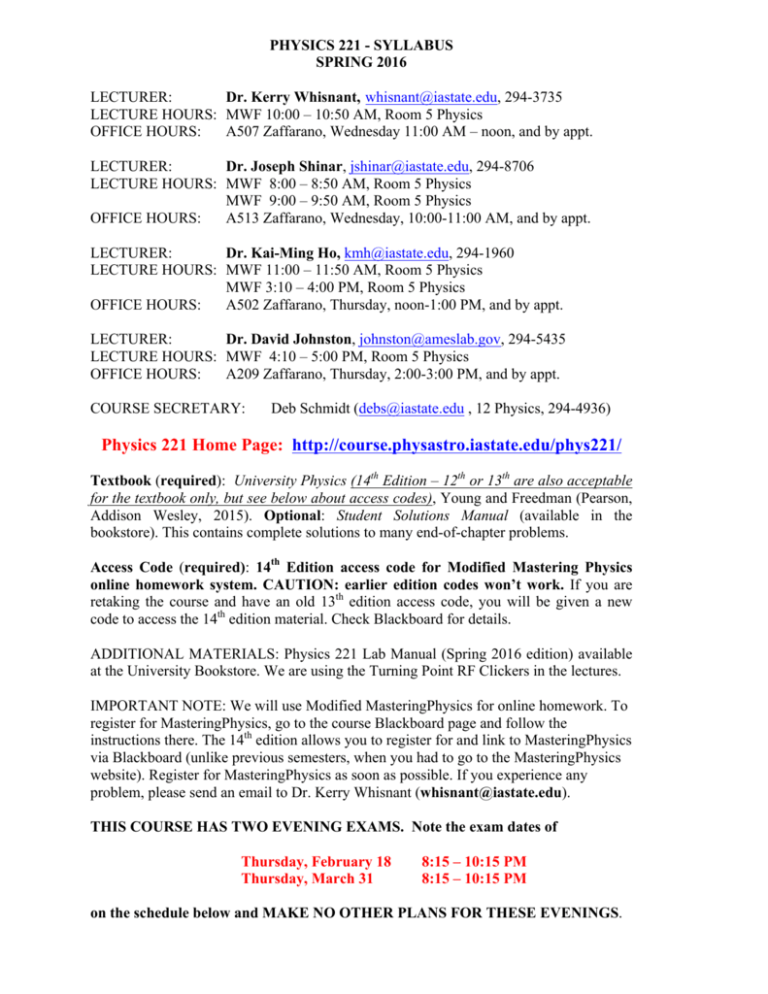
PHYSICS 221 - SYLLABUS
SPRING 2016
LECTURER:
Dr. Kerry Whisnant, whisnant@iastate.edu, 294-3735
LECTURE HOURS: MWF 10:00 – 10:50 AM, Room 5 Physics
OFFICE HOURS:
A507 Zaffarano, Wednesday 11:00 AM – noon, and by appt.
LECTURER:
Dr. Joseph Shinar, jshinar@iastate.edu, 294-8706
LECTURE HOURS: MWF 8:00 – 8:50 AM, Room 5 Physics
MWF 9:00 – 9:50 AM, Room 5 Physics
OFFICE HOURS:
A513 Zaffarano, Wednesday, 10:00-11:00 AM, and by appt.
LECTURER:
Dr. Kai-Ming Ho, kmh@iastate.edu, 294-1960
LECTURE HOURS: MWF 11:00 – 11:50 AM, Room 5 Physics
MWF 3:10 – 4:00 PM, Room 5 Physics
OFFICE HOURS:
A502 Zaffarano, Thursday, noon-1:00 PM, and by appt.
LECTURER:
Dr. David Johnston, johnston@ameslab.gov, 294-5435
LECTURE HOURS: MWF 4:10 – 5:00 PM, Room 5 Physics
OFFICE HOURS:
A209 Zaffarano, Thursday, 2:00-3:00 PM, and by appt.
COURSE SECRETARY:
Deb Schmidt (debs@iastate.edu , 12 Physics, 294-4936)
Physics 221 Home Page: http://course.physastro.iastate.edu/phys221/
Textbook (required): University Physics (14th Edition – 12th or 13th are also acceptable
for the textbook only, but see below about access codes), Young and Freedman (Pearson,
Addison Wesley, 2015). Optional: Student Solutions Manual (available in the
bookstore). This contains complete solutions to many end-of-chapter problems.
Access Code (required): 14th Edition access code for Modified Mastering Physics
online homework system. CAUTION: earlier edition codes won’t work. If you are
retaking the course and have an old 13th edition access code, you will be given a new
code to access the 14th edition material. Check Blackboard for details.
ADDITIONAL MATERIALS: Physics 221 Lab Manual (Spring 2016 edition) available
at the University Bookstore. We are using the Turning Point RF Clickers in the lectures.
IMPORTANT NOTE: We will use Modified MasteringPhysics for online homework. To
register for MasteringPhysics, go to the course Blackboard page and follow the
instructions there. The 14th edition allows you to register for and link to MasteringPhysics
via Blackboard (unlike previous semesters, when you had to go to the MasteringPhysics
website). Register for MasteringPhysics as soon as possible. If you experience any
problem, please send an email to Dr. Kerry Whisnant (whisnant@iastate.edu).
THIS COURSE HAS TWO EVENING EXAMS. Note the exam dates of
Thursday, February 18
Thursday, March 31
8:15 – 10:15 PM
8:15 – 10:15 PM
on the schedule below and MAKE NO OTHER PLANS FOR THESE EVENINGS.
Date
Class (lecture/recitation)
1. Introduction. Significant figures. Order of
magnitude
T Jan 12 Worksheet 1: Units
M Jan 11
Assignments
Quizzes
1.1-1.6
No quiz
W Jan 13 2. Vectors. Vector products and components
Read: 1.7-1.10
R Jan 14 NO RECITATION
Online 0 (Fri. 5pm)
F Jan 15 3. 1-dimensional motion
Read: 2.1-2.4
M Jan 18 NO CLASS TODAY--- M.L.K. HOLIDAY
T Jan 19 Worksheet 2: Vectors
Written 1
W Jan 20 4. Free fall
R Jan 21 Worksheet 3: 1D motion
Read: 2.5-2.6
Online 1 (Fri. 5pm)
F Jan 22 5. 2-Dim motion. Projectiles
Read: 3.1-3.3
M Jan 25 6. Circular motion
Read: 3.4, 9.1-9.3
Written 2
T Jan 26 Worksheet 4: 2D motion
W Jan 27 7. Relative motion
R Jan 28
NO RECITATION
Read: 4.1-4.4
M Feb 1 9. Newton’s 3rd law. Free body diagrams
Read: 4.5-4.6
Written 3
Worksheet 5: Newton’s laws
W Feb 3 10. Applications of Newton’s laws
R Feb 4 Group Problem 1 (Projectile motion: Mars probe)
Read: 5.1-5.2
Online 3 (Fri. 5pm)
F Feb 5
Read: 5.3-5.4
11. Friction. Circular motion dynamics
Q2: Lect. 3-4
Read: 3.5
Online 2 (Fri. 5pm)
F Jan 29 8. Forces. Newton’s 1st and 2nd Laws
T Feb 2
Q1: Lect. 1-2
Q3: Lect. 5-7
M Feb 8 12. Examples
T Feb 9
Worksheet 6: Free body diagrams
W Feb 10 13. Work and kinetic energy
Written 4
R Feb 11 NO RECITATION
Read: 6.1-6.2
Online 4 (Fri. 5pm)
F Feb 12 14. Work for varying forces. Power
Read: 6.3-6.4
M Feb 15 15. Energy conservation. Potential energy
Read: 7.1-7.3
Written 5
T Feb 16 Worksheet 7: Work and energy
W Feb 17 No lecture. Optional review session
Group Problem 2 (Energy: Ski jump)
R Feb 18
EXAM 1 (COVERS LECTURES 1-14)
Q4: Lect. 8-10
Q5: Lect. 11-12
Online 5 (Mon. 5pm)
F Feb 19 16. Conservative & nonconservative forces. Examples
M Feb 22 17. Energy diagrams
T Feb 23 Worksheet 8: Energy diagrams
W Feb 24 18. Linear momentum and impulse
Read: 7.4-7.5
Written 6
R Feb 25 NO RECITATION
Read: 8.1-8.2
Online 6 (Fri. 5pm)
F Feb 26 19. Elastic and inelastic collisions
Read: 8.3-8.4
Q6: Lect. 15-16
M Feb 29 20. Center of mass
T Mar 1 Worksheet 9: Linear momentum and center of mass
W Mar 2 21. Rigid body rotation. Moment of inertia
Read: 8.5
Written 7
R Mar 3 Group Problem 3 (Collisions: Car insurance)
Read: 9.4-9.6
Online 7 (Fri. 5pm)
F Mar 4 22. Torque
Read: 10.1-10.3
M Mar 7 23. Rotations: work, power and examples
Read: 10.4
Written 8
T Mar 8 Worksheet 10: Rigid body motion
W Mar 9 24. Angular momentum
R Mar 10 NO RECITATION
Read: 10.5-10.6
Online 8 (Fri. 5pm)
F Mar 11 25. Statics
Read: 11.1-11.3
Q7: Lect. 17
Q8: Lect. 18-20
MARCH 14 – 18 SPRING BREAK
M Mar 21 26. Elasticity.
T Mar 22 Worksheet 11: Angular momentum and statics
W Mar 23 27. Gravitation.
Read: 11.4-11.5
Written 9
R Mar 24 Group Problem 4 (Elasticity)
Read: 13.1-13.5
Online 9 (Fri. 5pm)
F Mar 25 28. Simple harmonic motion. Springs
Read: 14.1-14.4
M Mar 28 29. The pendulum. Damped and forced oscillations
T Mar 29 Worksheet 12: Gravitation
Read: 14.5-14.8
Written 10
W Mar 30 No lecture. Optional review session
EXAM 2 (COVERS LECTURES 15-27)
R Mar 31
NO RECITATION TODAY
Online 10
(Mon. 5pm)
F Apr 1
30. Mechanical waves. Transverse waves
Q9: Lect. 21-23
Q10: Lect. 24-27
Read: 15.1-15.8
M Apr 4 31. Sound waves. Energy. Intensity. Resonance
T Apr 5 Worksheet 13: Oscillations
Read: 16.1-16.3
Written 11
Q11: Lect. 28-29
W Apr 6 32. Interference. Standing waves. Beats. Doppler shift Read: 16.4-16.9
Online 11 (Fri. 5pm)
R Apr 7 Group Problem 5 (Waves on string: Wind sculpture)
F Apr 8
33. Temperature. Thermometers. Thermal expansion
M Apr 11 34. Heat and phase changes. Phase diagrams
Read: 17.1-17.4
Read: 17.5-17.6, 18.6
Written 12
Q12: Lect. 30-32
T Apr 12 Worksheet 14: Waves (Doppler and beats)
R Apr 14 NO RECITATION
Read: 17.7
Online 12 (Fri. 5pm)
F Apr 15 36. Equations of state. Ideal gas. Kinetic model.
Read: 18.1-18.4
M Apr 18 37. Maxwell-Boltzmann distribution. Phase diagrams
Read: 18.5-18.6
T Apr 19 Group Problem 6 (Heat transfer: Ice chest)
Written 13
W Apr 20 38. First law of thermodynamics.
Read: 19.1-19.4
R Apr 21 Worksheet 15: First law
Online 13 (Fri. 5pm) Q13: Lect. 33-34
F Apr 22 39. Thermal processes. Heat capacities
Read: 19.5-19.8
M Apr 25 40. Heat engines and refrigerators
Read: 20.1-20.4
Written 14
T Apr 26 Worksheet 16: Isothermal vs. adiabatic
W Apr 27 41. Second law of thermo. Carnot cycle
R Apr 28 Group Problem 7 (Elevator)
F Apr 29 42. Entropy
MAKEUP LAB
& MAKEUP
TEST WEEK
W Apr 13 35. Heat transfer
Read: 20.5-20.6
Online 14 (Fri. 5pm)
Read: 20.7-20.8
Q14: Lect. 35-38
EXAMS
MID-SEMESTER EXAMS: This course has evening exams. Note the exam dates:
Thursday, February 18
Thursday, March 31
8:15 – 10:15 PM
8:15 – 10:15 PM
on the schedule above, and make no other plans for these evenings. Evening exams are used in
this course so that all students can take the same exam at the same time and thus be graded on the
same basis. Room assignments and instructions will be posted and discussed in advance of each
exam. The exams this semester will be multiple-choice. Approximately 1/3 of the problems will
emphasize understanding of the physics concepts, whereas the remainder will be numerical
problems to test your ability to apply these concepts.
FINAL EXAM: May 2 – MAY 6, time and day TBA, 120 minutes
The date and time of the final exam will be announced when they become available. The final
exam covers all lectures with an emphasis on lectures 28-42 and includes the laboratory final
exam.
Conflicts: If you have a conflict with the scheduled time for the final exam or any other reason
why you cannot write it at the assigned time, you must notify Dr. Whisnant before 5 pm Friday,
April 22 so that an alternative arrangement may be found.
Bring to each exam a Number 2 pencil, a scientific calculator and your student ID card.
Programmable and/or charting calculators are not necessary but may be used. Laptops or PDA’s
are not allowed. Each exam will include the values of any physical constants you may need, a
formula sheet and scratch paper.
A single, end-of-semester, make-up exam will be allowed only in exceptional circumstances,
such as illness, family emergencies (not anniversaries, family vacations, etc.), or official
university-sponsored activities. Students who know in advance that they will miss an exam as a
result of one of these university-sponsored activities must explain the circumstances to the
lecturer well before the exam and seek permission to take a make-up exam. After the fact, such
permission will not be granted. Students who miss an exam because of illness or other
unforeseen emergencies should send a message (by phone, voice-mail, e-mail, or through a
friend) to the lecturer or the course secretary before the start time of the exam in order to receive
permission to take the make-up exam. This make-up exam will be held during the week before
finals week and will be a comprehensive exam. Only one exam can be made-up in this manner.
HOMEWORK
The assigned problems will be posted on the Physics 221 web page. There will be two types of
homework problems.
1. Online homework: Each student must purchase at the ISU bookstore or online a 14th edition
access code to the MasteringPhysics site and then log in as instructed on the Physics 221
Blackboard page. The online problem sets are generally due on Fridays by 5:00 pm and graded
automatically. NOTE: The deadlines for the online problem sets due the Fridays after the midsemester exams are moved to the following Mondays at 5:00 pm.
If you encounter difficulties with a submission, please consult the MasteringPhysics Instructions.
If that does not solve the problem, send an e-mail to Dr. Whisnant. Under exceptional
circumstances, and only under exceptional circumstances, (e.g. computer or server
breakdowns) hand-written solutions to homework will be accepted if they are delivered to the
Physics Office (12 Physics) mailbox by 5:00 pm, Friday.
2. Written Homework: The second type of homework will be a set of “long answer” problems
that will have to be handed in at the beginning of the Tuesday recitation section. These
problems will be posted on the course web page and can be printed out as needed. This problem
set will be graded by the recitation TA and handed back to the student by the following Tuesday
recitation section. The first written assignment is due Tuesday, January 19.
The solutions to the assigned written problems and to the online problems without hints will be
posted the day after the assignment is due.
When doing a homework problem, work it out step by step, clearly stating the principles utilized
and showing each step of the solution. In your assigned written homework problems, the
solutions should be written out neatly and clearly. The TA grading your written homework must
be able to follow the logic of the steps of your solution. Most of the credit for a written problem
will be for this and the correctness of the steps and only a minor fraction for the answer itself.
The answer to a numerical problem is wrong if the correct units are not part of the answer, even
if the numerical value is correct. In general, express numerical answers to written and online
homework problems with the correct number of significant digits.
It is to your advantage to work with other students so as to learn the material. This can often help
you to do better on the exams and homework. We encourage you to work together and perhaps
form a study group. You may meet in the Physics 221 help room, if you wish. Please see the
academic honesty statement for guidelines about working on homework assignments in a group.
N.B.: The three exams are worth 62.5% of your grade, and many of the problems on the exams
will be very similar to the assigned homework problems and the Example Problems in lecture
and in the text. In order to do well on the exams, you have to understand and be able to produce
the solutions to these problems! In particular, copying homework solutions rather than doing
them yourself in order to get a few recitation points is counterproductive and self-defeating, not
to mention academically dishonest.
RECITATIONS
There will either be two, 50-minute, recitations (Tuesday and Thursday) or one, 50-minute,
recitation (Tuesday) during any given week (see schedule).
The recitations in this course are conceived as a hands-on / interactive activity. Students will
work in small groups on a worksheet or problem provided by the recitation instructor. Discuss,
sketch, ask, explain, disagree, think aloud… but don’t sit back and wait for the instructor to solve
the problem on the board. Your instructor is there to help you through the problems, to answer
your questions and to monitor your understanding of the material. Learning is done best by
doing, not by watching.
Group problems: Thursday recitation activity will be a complex problem to be solved in a
group of 2 to 4 students. Group problems are handed in at the end of the period and graded by
the instructor.
Quizzes: At the end of every Tuesday recitation (except during the first week of classes), a 10minute quiz will be given. See schedule for material covered by each quiz. Quizzes will be
graded by the recitation TA and handed back to the students within a week.
Missed quiz: If you miss a quiz for a good reason (e.g. being sick, being away due to an ISU
related activity), you should bring some document to prove the reason of your absence to your
TA who will give you an Excused Grade (i.e., at the end of the semester your score for the
missed quiz will be the average of all your other quizzes).
LABS
All lab-­‐related information and material is in a separate Blackboard page called PHYS 221 LABS (Spring 2016). Access this page as soon as possible to: a. Read the Laboratory Information and Policies; b. Take the Laboratory Policies Quiz (you need a perfect score on this quiz); and c. Figure out when your lab section meets for the first time. In particular, make sure you understand the make-­‐up lab policies. If you have problems accessing the lab Blackboard page, please contact the lab supervisor, Paula Herrera (siklody@iastate.edu). Completing all the labs and the corresponding prelabs is a required part of 221. Failure to do so will result in an F for the entire course, independently of your performance in other components. The final exam will contain four questions about the labs. Lab waivers: •
If you have completed the laboratory part of the course successfully during a previous semester at ISU, you may request a lab waiver during the first week of classes. This is done through Blackboard. •
If this waiver is granted, your old lab grade will be used. •
You still have to answer the lab questions on the exams. GRADING
COURSE GRADES are based on a numerical score determined as follows:
Two, mid-semester night exams (75 points each)
Final exam
Quizzes
Online homework
Written homework
Group problems
Laboratory grade
Points
150
100
50
30
30
10
30
Maximum Total
400
Letter Grade Scale
≥ 325 ≥ A≥ 285 ≥ B≥ 245 ≥ C≥ 215 ≥ D<215 F
The above point scale for letter grades for the course will not be raised, but may be lowered. A
failing course grade (F) will be given if: (1) any laboratory has not been satisfactorily
completed, or (2) the student has engaged in any form of academic dishonesty.
Homework scores: Homework is an investment. The “direct” credit from homework is only
15% of the final score, but this is the most important learning tool in the course. Homework is
your opportunity to make mistakes and learn from them. Then you will be able to answer the
exam and quiz questions correctly, which carry 75% of the total points.
Recitation and lab scores: The precise number of recitation/lab points you receive from your
instructors during the semester will not necessarily be the same as the number that counts
towards your final grade. Some instructors grade “hard” during the semester and some grade
“easy”. Thus, in the interest of fairness to all the students, each instructor will be told the average
recitation/lab score to turn in. This means you will not automatically get a higher grade because
you have an easy grader, or a lower grade if you have a hard grader. An average student in an
average recitation section will receive about 70% of the maximum points possible.
Participation: There will be extra credit worth up to 10 points given for participation in lecture
based on the responses to the clicker questions. You need to register your clicker through
Blackboard in order to receive extra credit.
Gradebook: The gradebook is available online on Blackboard. There is a link to Blackboard on
the course web page. Log in using your regular ISU NetID and password. Please notify one of
the instructors if you have access problems. You should regularly check that all your scores are
correctly entered in the online gradebook. It is your responsibility to bring any problems to the
attention of your section instructor immediately.
Exam scores: If you believe there has been an error in the grading of an exam or in the final
grade assigned to you, you need to contact Dr. Whisnant no later than one week after the
results are released.
SUCCEED IN PHYSICS 221 !
Students often ask how they should study for the course and the exams. Some suggestions are:
•
Be sure to read the indicated reading assignments before each lecture. The reading
assignments are essential to understanding the material presented in the lecture.
•
Actively review (= redo without looking at the solution) the assigned homework
problems and solutions as well as recitation worksheets and quizzes. Be sure you
understand all of the concepts as well as steps associated with each problem.
•
As needed, reread the chapter summaries in the textbook. Review the appropriate sections
and/or go over your lecture notes.
•
Solve extra questions and problems in the textbook (the odd numbered problems have the
answers in the back of the book). Do as many additional end-of-chapter problems as you
need to do to thoroughly understand the material. The answers to the odd-numbered
problems are in an appendix at the end of the text, and the complete solutions to about
half of the odd-numbered problems are given in the optional Student Solutions Manual,
available in the bookstore.
•
Attend the review lectures prior to the exams and/or special review sessions scheduled by
recitation instructors.
•
Use exams from previous semesters for studying for the exams. They can be found on the
course web page. The level of difficulty will be about the same as of the exams this
semester.
STUDENT ASSISTANCE
There are several opportunities for students to receive assistance with the material of this course:
•
Room B54 Physics will be the Physics 221 Help Room. The staffing schedule will be
posted on the door and on the bulletin board. The first day of Physics 221 Help Room
is Tuesday, January 19. There will be no Help Room during finals week so that the
TAs can prepare for their own exams.
•
Instructor office hours.
•
The course web page.
•
Discussion board on Blackboard Learn.
•
SI sessions for Physics 221 (times to be announced by the SI instructors).
•
Tutors are available through the Academic Success Center
(http://www.dso.iastate.edu/asc/tutoring)
•
Bulletin boards outside of the lab rooms display material related to the laboratory.
Course Objectives:
The objective of this course is to provide a broad exposure to how humanity has created and
applied the language of math to describe basic physical phenomena. Whereas the class schedule
above provides a topic by topic list of specific subjects to be covered, broader goals are:
•
To gain clear understanding of how to use basic vector algebra and calculus to
describe and solve physical problems.
•
Understand how to use basic 1-, 2-, and 3-dimensional kinematics.
•
Know how to state, explain and use Newton’s laws of motion.
•
Understand and use concepts of momentum and energy as well as their conservation.
•
Apply Newton’s laws (and conservation laws) to point-like and continuous bodies.
•
Understand and describe oscillatory motion and wave mechanics.
•
Understand and use basic laws of thermodynamics.
Students with Disabilities
Iowa State University is committed to assuring that all educational activities are free from
discrimination and harassment based on disability status. All students requesting
accommodations are required to meet with staff in Student Disability Resources (SDR) to
establish eligibility. A Student Academic Accommodation Request (SAAR) form will be
provided to eligible students. The provision of reasonable accommodations in this course will be
arranged after timely delivery of the SAAR form to the instructor. Students are encouraged to
deliver completed SAAR forms as early in the semester as possible. SDR, a unit in the Dean of
Students Office, is located in room 1076, Student Services Building or online at
www.dso.iastate.edu/dr/. Contact SDR by e-mail at disabilityresources@iastate.edu or by phone
at 515-294-7220 for additional information.


